Sketches of Amberg Train History
In 1884 the Milwaukee & Northern
railroad reached the community of Pike and set up regular passenger
and freight service to the area. Prior to the arrival of the train, access to
the remote community was provided by the Pine River road that
continued north from Ellis Junction (Crivitz). Drivers had to strap
themselves in the high seats of the wagons to keep from being thrown
down due to the stumps and logs of the corduroy road that passed
through the numerous wetlands.
The Pike River road also provided access.
This road began in Marinette and was built by the Menominee River
Boom Company to haul supplies to the logging camps.
The railroad was a welcomed improvement and
made possible the transportation of the granite paving blocks,
building stones, and later gravestones, products of the granite
quarries that made Amberg a leading producer of granite in the
Midwest. Six years later the community of Pike became the Town of
Amberg and by 1905 the population had grown from a few settlers to 2,802.
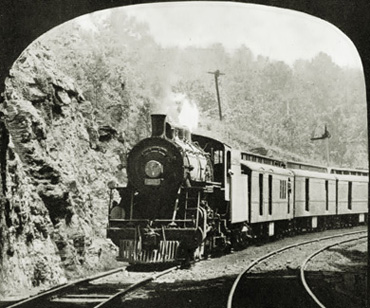 |
The "Cuts"
There is an area north of Amberg, similar to the rock ledge
shown in this photo, known as the "Cuts." It took about two
years for the crew to cut through the granite ledge. Two
blacksmith shops, a boarding house, and a tavern were built
there and remained until the work was completed. Near the
"Cuts" a spur was later built to the Aryle and Martindale quarries. |
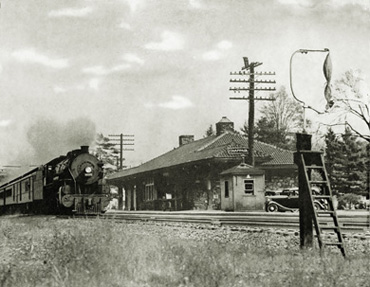 |
The Mail Bag
A mail crane enables the train to pick up mail without
stopping the train. There is a catcher arm attached to the
train that is adjusted so it catches the bag where it is
tied in the center. Incoming mail bags are thrown off
the train.
There is an interesting story in the Cedarville depot
exhibit when a store clerk sent a package by mail. Check it
out when you visit the museum. |
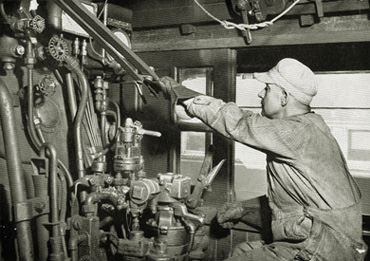 |
The Train Engineer
The engineer sits on the right side of the train to watch
the train and observe the signals along the track.
The long lever held by his left hand is the throttle that controls the speed of
the train. Below that lever is a small handle that controls
the engine's brakes. Below and to the left is a sand
control. Further down near his right hand is the air brake
that stops the train. The large lever on the right side of
the cab reverses the train's direction. See if you can find
the whistle cord?
|
 |
Keeping the Train On Time
The engineer and the conductor compare watches to make sure
they agree.
Prior to 1883, just before the railroad came to Amberg,
cities and towns went on "sun" time. In other words, each
had their own time.
After 1883 a standard time was developed. Clocks in railroad
stations were corrected daily. Railroad workers
could then adjust their clocks to keep the time uniform and
maintain regular schedules.
Trains were often identified by the time of departure. For
example, there was a 7:56 train arriving from Republic,
Michigan, on the 24th of January, 1861 at the Amberg depot.
|
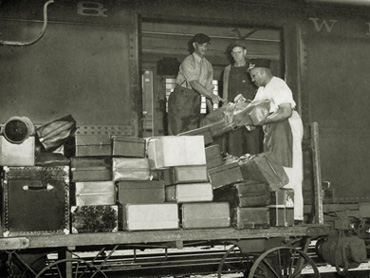 |
Loading Baggage
One of the jobs at the Amberg Depot was loading and
unloading baggage for the passenger trains that stopped at
the station.
The baggage car was usually located just ahead of the
passenger cars. It was used to transport trunks and smaller
pieces of baggage or suitcases. Other personal bulky
items such as bicycles, skis, or even pets were carried in
these cars.
An original baggage cart such as the one in the photo is on
display in the Amberg depot.
|
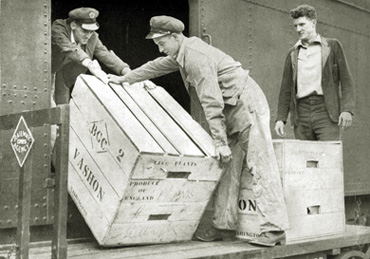 |
Hauling Freight
Hauling freight was a chief responsibility at the small
Amberg depot. Local businesses depended upon the railroad to
ship their goods for resale. People who moved to town shipped
their household goods by train. People living in town could take overnight
shopping trips to Marinette and then ship any goods purchased
back to town by the railroad.
Freight could also be shipped anywhere in the United States
by the Railway Express Agency. Need a new ice box or
refrigerator? You could purchase it using a Sears catalog and ship it
by Railway Express Agency right to the Amberg depot.
|
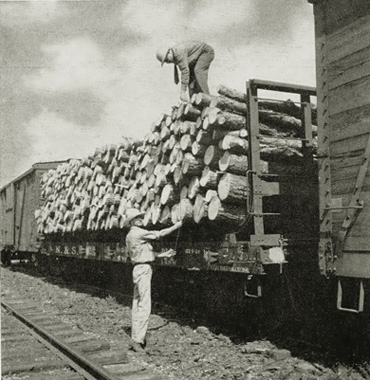 |
Shipping Logs
In the early years of logging, logs were moved by the
Menominee Boom Company down the Pike River which flows into
the Menominee River to sawmills in Menominee and Marinette.
The last river drive in the Amberg area occurred in 1913.
After the Menominee Boom company ceased, lumber companies
began building their own railroads to connect to the main
line, the Chicago, Milwaukee, & St. Paul, which
bought out the Milwaukee and Northern railroad in 1893.
|
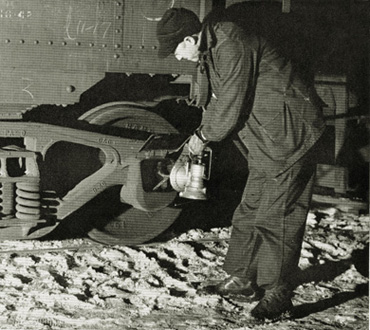 |
Car Inspectors
Incoming trains at larger stations and railroad yards such
as Green Bay were inspected regularly. Car inspectors were
one railroad worker who was always "looking for trouble."
In this photograph the inspector is examining the cotton
packing in the journal box to make sure it is properly
packed and oiled. Failure of a journal box caused friction
and the heat could require the train to stop to cool off.
Notice the lantern. There are several examples in the Amberg
Depot exhibit.
|
 |
Taking on Water
Steam engines require water to make steam. In this
photograph the fireman is filling the tender tank. These
tanks can hold as much as 15,000 gallons of water. The
tender also carries the fuel to run the engine. Most to the
steam engines ran on coal which is stored in the front of
the tender and shoveled into the engine by the fireman.
Amberg had a water tower located near the Amberg Granite
Company finishing shed just north of the depot.
|
 |
The Conductor
The conductor is like the captain of a ship. He arrived
before the train left the terminal to make sure all
personnel were ready for duty and the train was properly outfitted for the journey. He also collected tickets
and fares of passengers taking short trips and punched
tickets of other passengers who made stops along the way. It
was his responsibility to make sure the train left the
station at the exact time of departure. Under no
circumstances could a train leave the station before its
scheduled time. Can you think of a reason why?
|
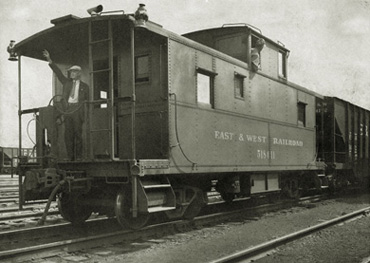 |
The Caboose
The caboose was the office of the freight train. The
conductor kept track of each shipment kept on the train.
The caboose was equipped with a table, water cooler, benches
and chairs, a washstand, and other conveniences for the crew
of the freight train. The cupola was where the conductor or brakeman
kept careful watch over the train. The wheel at the end
worked a hand brake. The ladder helped workers
climb on the roof to signal the engineer. Signal lights were
attached to brackets on the side of the caboose.
Today trains no longer use a caboose.
|
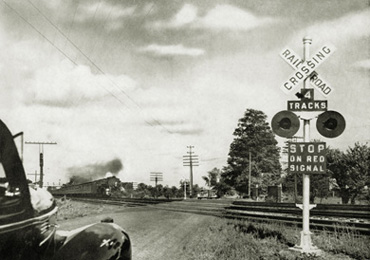 |
Railroad Crossings
Remember to "Stop, Look,
and Listen" at a railroad crossing.
In 1957 a death occurred in Amberg from a train when six-year-old Russell
Koster was killed. This exhibit is presented in his memory.
Bear in mind, "Better Safe than Sorry."
|
The above photographs were taken from "A
Study of Railway Transportation" by the Association of American
Railroads, Washington, D.C., 1945. The photographs and two-volume
teaching unit are now stored in the Amberg Museum archives.




















